For a perfect optical system, every ray that leaves a given object point P
successfully travels to the corresponding image point P'.
Lenses with spherical surfaces only image P to P' in the paraxial
approximation, when the light stays close to the optic axis and rays make small
angles with the optic axis. Otherwise the image of a point can become a
more or less smeared out blob.
Link:
Aberration (Nikon)
Open this link and see pictures of the different
types of aberrations as you read about them below.
Also please watch all the short Youtube videos linked on this page.
Spherical aberrations
Spherical aberrations dominate when
a wide beam, which is parallel to the optic axis, is focused by a
converging lens with spherical surfaces. The focal length for rays
which travel through the outer regions of the lens is shorter than that
for the rays traveling through the center of the lens.
The figure to
below shows rays incident parallel to the optical axis from a very
distant on-axis object point, such as a star. They are refracted as they travel towards the
paraxial focal plane. The least blurry image is produced a short
distance to the left of the paraxial focal plane and is called the circle of
least confusion.
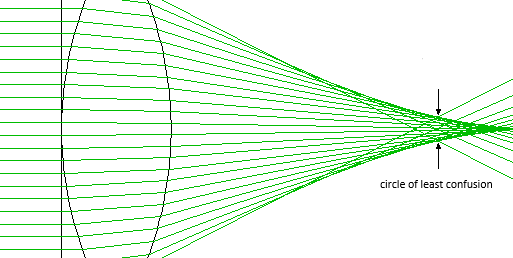
The amount of refraction at the two surfaces of the lens is not the same. Spherical aberrations can be reduced by equalizing the amount of refraction at
both surfaces of a lens. This can be done by varying the shape of the lens,
while keeping the index of refraction, thickness, and focal length constant. Only the radii of the lens are changed. This is called bending the lens.
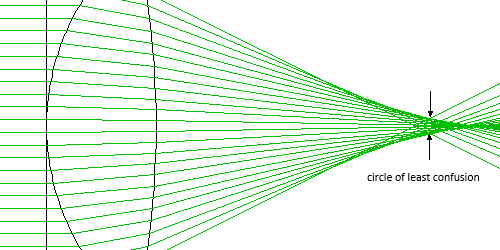
Due to spherical aberration, the image of an object point that lies on the
optical axis is not a point but a spherical blob.

Link:
YouTube, Spherical Aberration
Coma
Coma aberrations degrade the image of an off-axis object point. The point
is imaged to a blob, whose shape resembles that of a comet tail. A streak
of light appears to emanate from a focused spot. On a sunny day use a
magnifying glass to focus an image of the sun. When you tilt he magnifying
glass with respect to the line of sight to the sun, the sun's image will
elongate into a comet-like shape that is characteristic of coma aberration.
Link:
YouTube, coma aberration
Astigmatism
Astigmatism aberrations degrade the
images of off-axis object points formed by lenses with spherical
surfaces and the images of all points formed by lenses with two
different radii of curvature in two perpendicular planes. (These
are lenses
that are shaped more like a football than a sphere.) The image of
an off-axis point appears as a line or ellipse instead of a discrete
point. Rays that propagate in two perpendicular planes have
different focal points. Astigmatism is very common in the human eye.
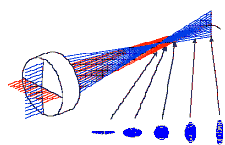 Because there are two different image planes, an object with spokes can have
an image in one plane for which the vertical lines are sharp, but lines that make an angle
with the vertical become more and more blurred as the angle approaches 90o. In the other image plane, horizontal lines can be sharp and vertical
lines are blurred. Eye examinations detect astigmatism if the spokes appear to
go from black to gray.
Because there are two different image planes, an object with spokes can have
an image in one plane for which the vertical lines are sharp, but lines that make an angle
with the vertical become more and more blurred as the angle approaches 90o. In the other image plane, horizontal lines can be sharp and vertical
lines are blurred. Eye examinations detect astigmatism if the spokes appear to
go from black to gray.
Assume we want to image an off-axis object point
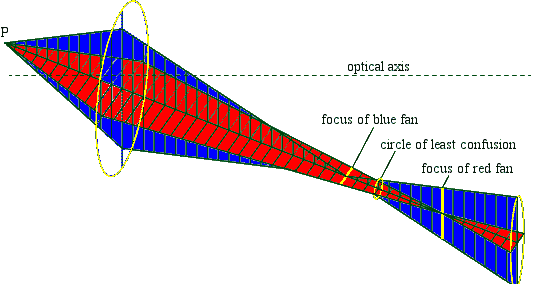
If we move a screen into the focal plane of the blue fan, then
the image of a point is a horizontal line segment. The image of a series of
points forming a horizontal line will be a sharp horizontal line formed by
overlapping horizontal line segments. But the image of a series of points
forming a vertical line will be a very blurry vertical line formed by vertically
stacked horizontal line segments. If we move the screen into the focal plane of
the red fan, then the image of a point is a horizontal line segment. Now the
image of a series of points forming a vertical line will be a sharp vertical
line formed by overlapping vertical line segments. But the image of a series of
points forming a horizontal line will be a very blurry horizontal line formed by
horizontally stacked vertical line segments.
Extended object aberrations
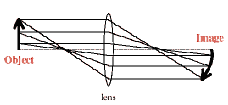 Curvature of field is not a point aberration, but an aberration associated
with an extended object. When extended objects are imaged with spherical lenses all
transverse points on the image are in focus at the same time on a
curved surface instead of on a plane. On a plane screen capturing the image, the
center and the outer regions of an extended object are in focus at different
distances away from the lens. This defect is called Petzval curvature or
curvature of field defect.
Curvature of field is not a point aberration, but an aberration associated
with an extended object. When extended objects are imaged with spherical lenses all
transverse points on the image are in focus at the same time on a
curved surface instead of on a plane. On a plane screen capturing the image, the
center and the outer regions of an extended object are in focus at different
distances away from the lens. This defect is called Petzval curvature or
curvature of field defect.
 Distortion is another aberration associated with extended objects is
distortion. Distortion results when the magnification is a function of the
distance away from the optical axis. Distortion is what causes vertical lines to bulge outward
(barrel distortion) or inward (pincushion distortion) at the image plane.
Distortion is another aberration associated with extended objects is
distortion. Distortion results when the magnification is a function of the
distance away from the optical axis. Distortion is what causes vertical lines to bulge outward
(barrel distortion) or inward (pincushion distortion) at the image plane.
Chromatic aberrations
Chromatic aberrations result from material dispersion. Because
Snell's law depends on the index of refraction n, and different
colors of light refract by different amounts, an image point formed by light of
one color does not coincide with the corresponding image point formed by light
of a different color. This is not a geometrical aberration.
Images formed by spherical mirrors can also be affected by spherical
aberrations, coma, astigmatism, curvature of field and distortion. But
images formed by spherical mirrors are free from chromatic aberrations, since,
unlike Snell's law, the law of reflection does not depend on the index of
refraction n.
Problem:
A real spherical concave
mirror does not perfectly focus the light from a point source. This can be
due to which defects?
Solution:
- Reasoning:
Point aberrations associated with spherical surfaces are spherical
aberrations, coma, and astigmatism. A mirror produces no chromatic
aberrations, since the law of reflection does not involve the index of
refraction.
Link:
How Lenses Function (Canon Official) (Youtube)
 Because there are two different image planes, an object with spokes can have
an image in one plane for which the vertical lines are sharp, but lines that make an angle
with the vertical become more and more blurred as the angle approaches 90o. In the other image plane, horizontal lines can be sharp and vertical
lines are blurred. Eye examinations detect astigmatism if the spokes appear to
go from black to gray.
Because there are two different image planes, an object with spokes can have
an image in one plane for which the vertical lines are sharp, but lines that make an angle
with the vertical become more and more blurred as the angle approaches 90o. In the other image plane, horizontal lines can be sharp and vertical
lines are blurred. Eye examinations detect astigmatism if the spokes appear to
go from black to gray.



 Curvature of field is not a point aberration, but an aberration associated
with an extended object. When extended objects are imaged with spherical lenses all
transverse points on the image are in focus at the same time on a
curved surface instead of on a plane. On a plane screen capturing the image, the
center and the outer regions of an extended object are in focus at different
distances away from the lens. This defect is called Petzval curvature or
curvature of field defect.
Curvature of field is not a point aberration, but an aberration associated
with an extended object. When extended objects are imaged with spherical lenses all
transverse points on the image are in focus at the same time on a
curved surface instead of on a plane. On a plane screen capturing the image, the
center and the outer regions of an extended object are in focus at different
distances away from the lens. This defect is called Petzval curvature or
curvature of field defect. Distortion is another aberration associated with extended objects is
distortion. Distortion results when the magnification is a function of the
distance away from the optical axis. Distortion is what causes vertical lines to bulge outward
(barrel distortion) or inward (pincushion distortion) at the image plane.
Distortion is another aberration associated with extended objects is
distortion. Distortion results when the magnification is a function of the
distance away from the optical axis. Distortion is what causes vertical lines to bulge outward
(barrel distortion) or inward (pincushion distortion) at the image plane.